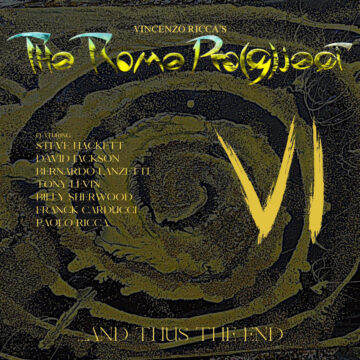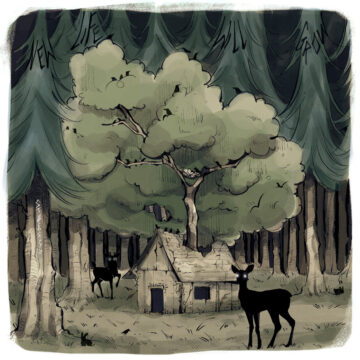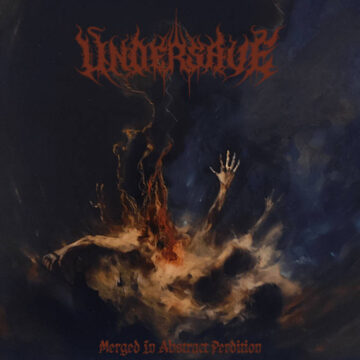Review: Hexrot – Formless Ruin of Oblivion

Style: Avant-Garde Metal, Progressive Death Metal, Technical Thrash Metal
Recommended for fans of: Gorguts, Death, Ulcerate, Deathspell Omega, Blut Aus Nord
Country: USA (Massachusetts)
Release date: 29 August 2025
The 2020s have seen a resurgence of inspiration and ambition in the furthest reaches of weirdo progressive/avant-garde death metal. Some groups like Mefitis, Haxprocess, and Voidceremony stick closely to the fundamentals of the genre laid down in the ‘90s, iterating upon common tropes and techniques while exploring further down familiar aural pathways than ever before. Other groups such as Diskord, Atvm, and Plague Rider eschew tradition almost entirely, pushing the boundaries of structure and tonality further than ever while still at least attempting to stay within the framework of traditional progressive death metal. Hexrot sit somewhere in the middle, providing one of the clearest throughlines I’ve heard between the modern scene and the old school ethos. Familiar ideas and techniques are touched up with modern ornamentation, while the songwriting itself constantly shifts between the worlds of old school and new school. Hell, the very first riff to be heard on intro track “What Lies Veiled” sounds as if Chuck Schuldiner were Tool’s number one fanboy, as if Hexrot were taunting: “Yes, we play progressive death metal, how could you tell”? One can nearly picture the sneering faces and hear the irony through the riff itself, until the whole thing falls apart about halfway through the track, signaling the avant-garde weirdness to come.
Formless Ruin of Oblivion is Hexrot’s debut full-length album, following and improving upon the meandering, subtly complicated sound explored on 2022’s Gloomwrought EP. Hexrot’s particular brand of avant-garde progressive death metal is akin to a pair of mirrors facing each other from a few paces away; riffs undergo a near constant proliferation, fragmenting and obfuscating the bigger picture the deeper one gazes into their details. One riff will introduce an idea, only to be cut off by another riff that has started a third of the way through itself. The first riff then returns and is cut off again at a different point, an arpeggio gets thrown in, the full version of the second riff is played, then finally the last bit of the first riff, before the entire passage is finally played on a clean distortion and with the tempo dropped by twenty percent. Such a fractured approach to songwriting allows Hexrot to squeeze much more mileage out of their melodic identity, with nearly any section of any riff able to be treated as a recurring motif to be recontextualized and reanimated in service of a song’s scaffolding as needed. I’m reminded of Suppression’s 2022 debut, The Sorrow of Soul Through Flesh, which harbored a similar phenomenon: in a manner, there are two separate listening experiences packed into a single album. One could float through Formless Ruin of Oblivion’s thirty-five-minute runtime, simply enjoying the textures and performative wizardry at a surface level and be totally justified and rewarded with such a listening approach. There are plenty of landmarks and Big Moments™ to catch the listener’s ear, guiding their attention at the most crucial junctions.
While our first imaginary listener is enjoying themselves in ignorant bliss, though, another listener could go down the rabbit hole of near-endless complexities arising from Formless Ruin of Oblivion’s maddening structural conceit. Hexrot walk on a tightrope of intricacy, with each rhythm and note placement being deliberate nearly to the point of prescience. Moment to moment, Hexrot refuse to fully reveal their hand, showing only enough for the listener to catch a glimpse of some larger picture hidden just outside of the peripheral. Clever use of subtle subdivisions masks an already near constantly shifting meter, acting as a force multiplier to the rhythmic vertigo that Formless Ruin of Oblivion is capable of inflicting. Riffs glide effortlessly through the rapid fire metric modulations, each moment either head-scratchingly complex or falling into a subtle, comfortable flow, depending on how the listener chooses to interact with the music. Not only do Hexrot mess around with meters and subdivisions, they are also capable of shifting the tempo itself on a dime while maintaining the structural complexity, showcasing an authentic trust, familiarity, and interplay between band members—even more impressive when paired with the realization that Formless Ruin of Oblivion was recorded as a live studio session.
As if masterful performances and an obsessively detail-oriented songwriting approach were not enough, Hexrot find a way to propel their sound even further into the modern age—taking inspiration from contemporaries like Diskord and Atvm in particular—making use of electronic textures and eclectic instrumentation to add yet another layer to their sound. Something that sounds like a woodblock first appears in “Heavenward” and continues to pop its head up over the course of Formless Ruin of Oblivion’s runtime, a simple yet effective way to introduce a recurring theme. “Consecrating Luminous Conflagration” begins with a drum beat utilizing bongos in its fill, and a xylophone accents seemingly arbitrary notes around two-thirds of the way into the track. Flourishes of electronic ambience add texture at key points during every track, often helping along transitional sections or ornamenting climaxes. All of these extra details may seem random or quirky for the sake of being quirky, but similarly to the structure of the compositions themselves, nothing Hexrot do is without purpose or planning.
Formless Ruin of Oblivion truly ascends past its genre peers during its closer—the title track—which itself comprises nearly half of the total runtime. Within the first few minutes, Hexrot already throw every eccentricity presented previously at the listener in a flurry of acrobatic twists and turns. Even during such an impressive display, Hexrot find the time to introduce new ideas and textures, such as superimposing spoken word sections onto the madness and bringing the electronic elements to their harshest utilization yet. All of this culminates around five minutes in, where a massive shift in dynamics introduces yet another novel textural shift in the form of a slower acoustic section that is reminiscent of Morbus Chron or Sweven. Hexrot continue their assault for another ten minutes, masterfully juggling their entire gamut of sound, familiarities and oddities alike, until the distinction between the two ends is muddied to the point of insignificance.
Such is the true magic behind Hexrot’s sound; they succeed at marrying a decidedly old school ethos to a brazen modernity, intertwining the full spectrum of each so fully that it is impossible to tell whether the former arises from the latter, or vice versa. The result is not so much of a dialectical collision of eras as it is an auditory ouroboros, a constant demolishing and rebuilding of familiar sounds and contexts being fed into the maw of cyclical rebirth, until the final moments of textural ambiance introduce the entire album anew. Formless Ruin of Oblivion has quickly risen among the ranks of my favorite avant-garde metal releases of the decade so far, and with it, Hexrot have secured their seat among the pantheon of progressive death metal weirdos for my tastes as well.
Recommended tracks: Heavenward, Clandestine Haunt, Formless Ruin of Oblivion
You may also like: Atvm, Diskord, Haxprocess, Felgrave, Castevet, Krallice
Final verdict: 9/10
Related links: Bandcamp | Facebook | Instagram | Metal-Archives
Label: Transcending Obscurity Records – Bandcamp | Facebook | Official Website
Hexrot is:
– Arkain (Guitars, Bass, Vocals)
– Melmoth (Drums, Vocals, Electronics)



1 Comment
Our August 2025 Albums of the Month! - The Progressive Subway · September 22, 2025 at 14:00
[…] Recommended tracks: Heavenward, Clandestine Haunt, Formless Ruin of OblivionRelated links: Bandcamp | original review […]